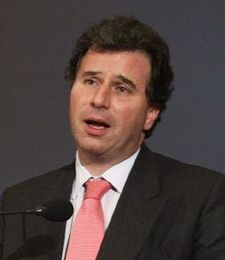
We tend to become riveted on the efforts of national governments to address greenhouse gas reductions, so far with dismal results. But as a valuable new study reminds us, city administrations can play a significant role in mitigation and with more immediate effect. Cities and Greenhouse Gas Emissions: Moving Forward is to be published in the journal Environment and Urbanization in April and has been made available online in advance. The lead author is Daniel Hoornweg, lead urban specialist on Cities and Climate Change at the World Bank.
A large share of global greenhouse gas emissions is attributable to cities. But the study points to cities’ ability to respond to climate change at a local and proximate level; cities usually offer more immediate and effective communication between the public and the decision makers than national governments. Cities, say the authors, are credible laboratories of social change, with sufficient scale to bring about meaningful changes. The potential co-benefits of mitigation and adaptation are largest in cities.
The study proposes a path forward for cities which clearly measure and communicate their emissions. They can identify and tackle the largest issues first. They can get help from citizens, other cities and national governments. The study recognises the pragmatism with which cities have been able to tackle other issues such as waste management and water supply, seeing that as a likely indicator of the way they can address climate change.
Cities vary greatly in their per capita levels of greenhouse gas emissions, and the study includes many interesting analyses and comparisons. It is surprising – and encouraging – to see how much work has been done on the measurement of a large number of cities’ per capita emissions. The study refers to 100 for which peer-reviewed studies are available, discussing some of them in closer detail. In most countries per capita greenhouse gas emissions are lower in cities than the country-wide average, but there are often considerable differences between cities within the same country. For example, the per capita emission level in the USA is 23.59 tonnes of CO2 equivalent (tCO2e) per annum. The average level of emissions for New York residents is considerably less at 10.5 tCO2e, yet Denver’s approaches the national average at 21.5 tCO2e. The difference between the two cities is mainly attributable to New York’s greater density and much lower reliance on the automobile for commuting. A review of Denver’s emissions which includes the embodied emissions of material such as food and concrete coming into the city has emissions rising to 25.3 tCO2e per capita, which is above the national average.
Chinese cities are atypical in that, generally, their GHG emissions are, on average, much higher than per capita national averages. For example, Shanghai’s emissions are 12.6 tCO2e per capita, while national emissions are 3.4 tCO2e per capita. This reflects the high reliance on fossil fuels for electricity production, a significant industrial base within many cities and a relatively poor and large rural population, and hence a lower average per capita value for national emissions.
The study offers interesting material relating to Toronto where researchers have broken down the city into districts. Wealthy neighbourhoods and distant sprawling suburbs had significantly higher emissions, dramatically so by comparison with a dense inner-city neighbourhood with good access to public transportation.
Greenhouse gas inventories are obviously important in giving city government bodies reliable information to work with, to share with their citizens and to determine where best to direct mitigation efforts. The study considers that while the making of inventories is still an evolving process it is robust enough already to be operated by all cities, at least by those with more than a million inhabitants. I thought of Mayor Len Brown’s plans for emission reductions in Auckland over the next fifteen years when I read this, and realised that this important pre-requisite should be within that city’s reach.
A striking feature in the study for me was the table which lists the policy tools available for city-level action on climate change. Transport figures heavily in the policy goals. Land use zoning can be used to reduce trip lengths, to encourage transit-oriented development zones and to introduce traffic calming to discourage driving. The quality and linkages of public transport can be improved and its services expanded. Employee transport plans can be facilitated. Driving and parking restrictions can be applied, and softened somewhat for fuel-efficient vehicles. The city fleet can be made up of fuel-efficient vehicles. All these are mitigation measures, some of them regulatory, some service provisions. Unfortunately in New Zealand at present those relating to public transport would come up against the Minister of Transport’s benighted determination to put public transport on short rations and spend the money on new roads, but at least in the case of Auckland there are signs of steel in the new Mayor’s public transport intentions.
Next on the list are policy tools relating to building efficiency. Zoning regulations can promote multi-family and connected residential housing. Energy efficiency requirements can be part of building codes. Public and private retro-fitting programmes can be co-ordinated.
The increase of the local share of renewable and captured energy generation can be obtained by building codes requiring a minimum share of renewable energy, by district heating and cooling projects and by waste-to-energy programmes.
Adaptation appears on the list with measures to reduce vulnerability to flooding and increased storm events and to extreme heat. Tree-planting programmes and green roof requirements figure here.
City officials and elected representatives don’t have to scratch their heads and wonder where they can start in the battle to reduce emissions or adapt to the climate change impacts which can’t be avoided. Nor do they have to join the “after you” brigade of international governmental negotiators. They can get under way immediately, either to lower their emissions substantially or, if they are already low to keep them that way as the city grows or becomes more prosperous. Cities can also work co-operatively in their endeavours. Some of the largest are already doing so. The study remarks on the C40 organisation, a group of large cities committed to tackling climate change, currently chaired by Mayor Michael Bloomberg of New York. Relative to the world’s top nations they are collectively a very big player and anything they prove able to achieve must be significant in global terms.
As we watch what looks like the sad spectacle of implosion in the US attempts to tackle climate change at the national level one is wary of sounding enthusiastic about mitigation prospects, but this paper is nevertheless a positive reminder that not everything depends on a handful of anti-science Republican congressmen. Cities can carry hopes which their countries currently largely deny.
[Nick Lowe]
Like this:
Like Loading...


 ames Hansen was in China when the American midterm elections were held, and he reports that while the rest of us were feeling pessimistic he was becoming optimistic. Not because of what was happening in the US, but because of China. He found two reasons for optimism, the first of which he has explained in a
ames Hansen was in China when the American midterm elections were held, and he reports that while the rest of us were feeling pessimistic he was becoming optimistic. Not because of what was happening in the US, but because of China. He found two reasons for optimism, the first of which he has explained in a 
 Two modestly hopeful signs from the political world struck me when reading today’s Guardian news. One was the opening of the climate change talks at Tainjin in China aimed at refining possible goals for the Cancun talks in November-December. The comment of Oxfam observer Kelly Dent attracted my attention. Oxfam is a careful watchdog of climate negotiations.
Two modestly hopeful signs from the political world struck me when reading today’s Guardian news. One was the opening of the climate change talks at Tainjin in China aimed at refining possible goals for the Cancun talks in November-December. The comment of Oxfam observer Kelly Dent attracted my attention. Oxfam is a careful watchdog of climate negotiations.